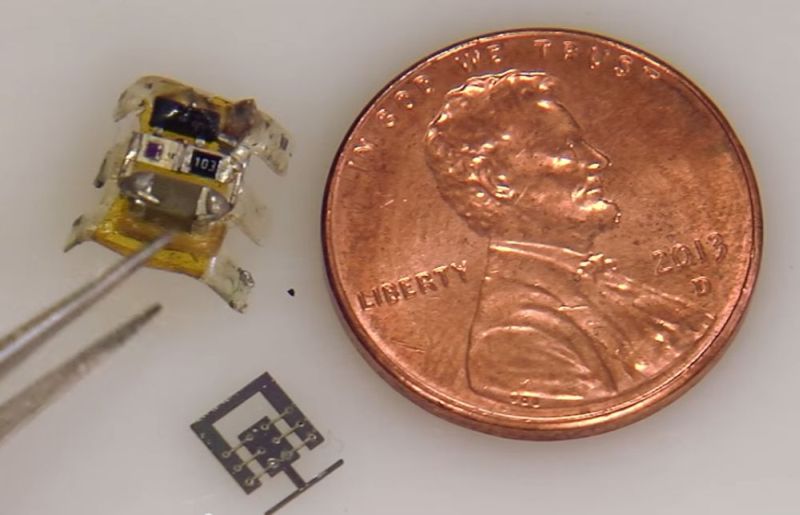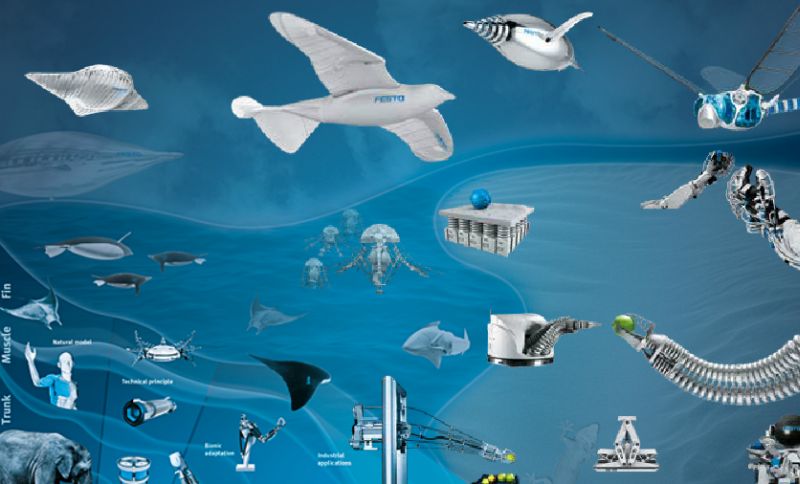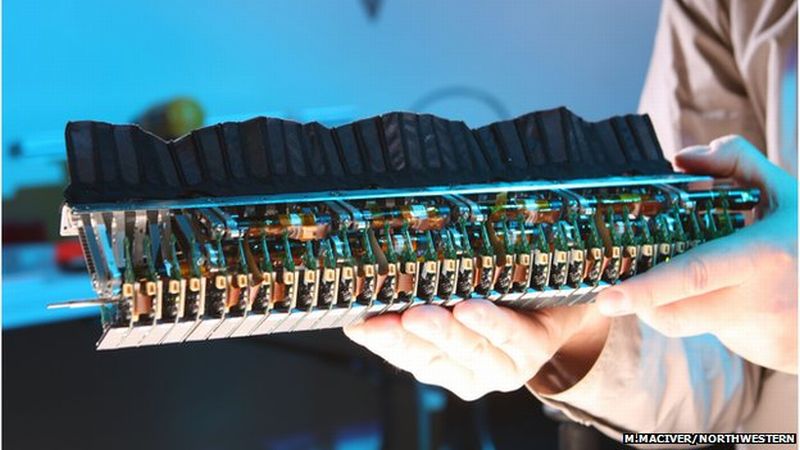Biomechatronics researchers at Bielefeld University, Germany have come up with a bot called Hector that is inspired from stick insect, another invention in the field of biomimicry. The insect bot has six limbs with an ability of functioning independently. The embedded sensors help it in reacting autonomously to its external setting and accordingly assist in learning from experience. Only for research platform Jan Paskarbeit, the developer envisions Hector in areas like testing animal locomotion theories. The bot however, is not designed with an intention of severing humans in areas like…
Read MoreTag: biomimicry
Sepios the Nautical Robot inspired by Cuttlefish: Biomimicry
The Swiss Federal Institute of Technology (ETH) in Zürich has come up with a robot, movement of which is inspired from cuttlefish. One of its own kind, Sepios is a bot with four orthogonal fins. Peep on the link below and see the undulating fin propulsion from the ETH’s nautical robot:
Read MoreBiomimicry: Robotic Spy Fish will do the Reconnaissance (ISR) Missions
Boston Engineering in collaboration with the U.S. Navy is developing a ‘tuna fish’, their new unmanned underwater vehicle. Developers envision that the fish would autonomously navigate across the sea for fetching information including surveillance and reconnaissance (ISR) missions. The project has been named Project Silent Nemo that comes from Disney’s famous movie, Finding Nemo, where Nemo was the subject of search but in here, Nemo will do the finding. Swimmer drone The unmanned underwater vehicle weighs around 100-pound while it’s length is about 5 feet. As a product of…
Read MoreRobots would now Learn to Fall from Cats and Divers: Biomimicry
It’s not just the design but the falling mechanics too are being studied for implementation by researchers in biomimicry. In an attempt to develop natural reflexes in robots, scientists at the US are studying the techniques through which cats and athletes twist their body mid-air without being injured at the landing. By recreating the similar reflexes in droids, researchers aim to cut down the probability of robots crashing especially during hazardous missions like search-and-rescue operations.
Read MoreBiomimicry: Cyborg Cockroach would be the New Rescuers
Cockroaches are one organism that is disliked by a majority of people but these creepy looking creatures is soon going to help in tracing humans trapped in disaster sites. Similar to penny sized micro robots, these tiny roaches can make its way through the extremely small spaces where others like dogs, camera or robots might not reach thus making rescue operation slow and risking lives of people.
Read MoreBiomimicry: Baby Elephant with Parallel Mechanism Legs
Until recently, most robots were designed to assist humans, right from the kitchen to their office premises we have seen these bots performing multi-tasking. Many fascinated machines have been fabricated keeping the nature in mind and this has led to a new field within robotics called the biomimicry. Every now and then, researchers come up with mind blowing ideas and concepts which creates an awe amongst the masses and this time, researchers at Shanghai Jiao Tong University, Shanghai, China has created the same wave with their ‘baby elephant’. The robot…
Read MoreMagnetoSperm Microrobots for the Nanoworld: Biomimicry
Nature does not stop us marveling at its splendor be it at macro level or micro scale. There are limitless options to investigate and get inspired. Biomimicry is one such field in robotics, which is completely drenched with nature’s splash. Researchers do not leave any stone unturned when dealing with robos inspired from nature, lately a concept is put forward by experts at the University of Twente, Netherlands. They have taken inspiration from nature’s locomotion at microscale and have combined the process of two micro-scale entities like magnetotactic bacteria and…
Read MoreSprinting Robot Raptor based on Velociraptor: Faster than Cheetah
Whenever we talk about speed and agility, first thing that comes to our mind is Boston Dynamics Cheetah, which runs at a speed to about 45.5 km/h. Until now, none of the bots have been able to give tough fight to the big cat, however, it seems, researchers at KAIST are preparing to stand tall with their new sprinter, Raptor. It has shown an impressive speed of 46 km/h, which happens to be slightly more than the big cat. Wow! Experts at the Korea Advanced Institute of Science and Technology’s…
Read MoreBiomimicry: Outrunner’s Steering based on Bipeds Walking Mechanism
In an effort of inculcating the sci-fi trends – where robots are doing the great things – into the real world, researchers at the Robotics Unlimited, a spinoff of the Institute for Human and Machine Cognition (IHMC) in Florida, are working hard towards designing bots that might assume a role into the everyday life of humanity. Thinking on the same lines, they have developed a Kickstarter project, aim of which is to fabricate next-gen robots. The robots are designed keeping simplicity and convenient operation in mind along with affordability. After…
Read MoreBiomimicry: Tabbot Mimics Cartwheel Movement of Desert Spider
After the termites inspired crew of tiny autonomous bots, insect-inspired Micro-Robots and Gimball, biomimicry has a new entrant called the Tabbot. It is a tiny bot inspired from Morocco based spiders famous for doing cartwheels effortlessly. Interestingly, these spiders are capable of doing cartwheels up and down the sand dunes. Ingo Rechenberg, a professor at the Technical University of Berlin has been credited for this discovery. In order to preserve and utilize the resourcefulness of this unique mode of locomotion, the researcher has already fabricated a small bot that works…
Read MoreBiomimicry: Insect-Inspired Micro-Robots For Stealthy Surveillance
Drawing inspiration from tiny insects, researchers at the University of Maryland, are developing the world’s tiniest mobile robot, suitably named as micro robots. These tiny robots are designed to take the long distance leap just as bugs do, with the aim of moving quickly or jump over any obstacle with ease in extremely rough terrain. Sarah Bergbreiter leading the research and other teammates from UM, envision the micro robots helping rescue teams in searching victims by quickly crawling through the rubble, at the disaster site, where humans and other traditional…
Read More10 Festo Robots Based on Their Biological Models: Biomimicry
Festo, a Germany based industrial control and automation company has been into research and development of bionics since more than two decades. It collaborated with renowned universities, institutes, development companies and private inventors across the globe and launched the Bionic Learning Network during 2006. And since then it has been delving into the subject and bringing about the best of biomimicry. Every time their new project gets into air, they prove how they are able to merge industrial automation, and combining electronics with pneumatics in new and efficient ways. Here…
Read MoreBiomimicry: RoboClam Replicates Atlantic Razor Clam’s Dynamics
Biomimicry: RoboClam Replicates Atlantic Razor Clam’s Dynamics In order to understand the efficient workings of flora and fauna, scientists always try to emulate nature’s wisdom, to which they call biomimicry. In one such attempt, researchers at the Massachusetts Institute of Technology have created RoboClam that digs itself into the soil to annihilate mines and to bury anchors. Atlantic razor clam (Ensis directus) has a stiff shell yet it is able to thrust itself through soil with a rate of 1cm/s. It’s been long since researchers were working upon the mechanism as…
Read MoreHyQ: The Most Versatile Quadruped Robot
With its first launch, HyQ, the brainchild of Italian Institute of Technology had already conquered how to manipulate the terrains. Now the quadruped robot has resurrected but with more tricks than before. Claudio Semini, the lead researcher claimed that the ‘second coming’ of HyQ is sodden with wide variety of motion skills that would help the bot in facing the dynamically changing terrain. Initially, the bot was designed in terms of reactive behavior, the mode that helped it from recovering from huddles but this time, the focus is kept on making…
Read MoreGhost Knifefish Inspired Autonomous Underwater Vehicle: Biomimicry
In an attempt to design an underwater vehicle that can go into the depths of ocean, which are not, accessible or not safe for humans to dive in, scientists are studying the Ghost knifefish method of locomotion. The fish are known to hunt in the murky water of the Amazon basin with precision and to sense the environment, rely on the current that they pass through the water and whirl their long fin for smooth motion to move both horizontally (forward and backward) as well as vertically.
Read More














